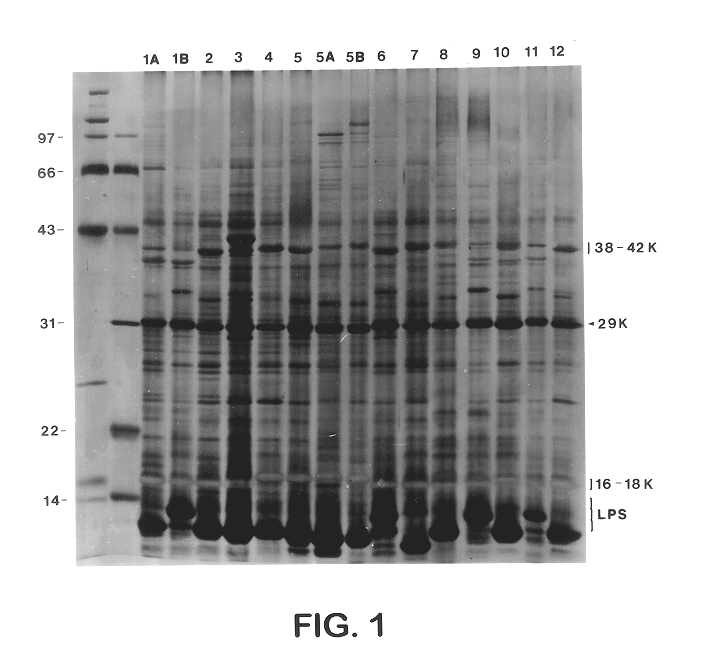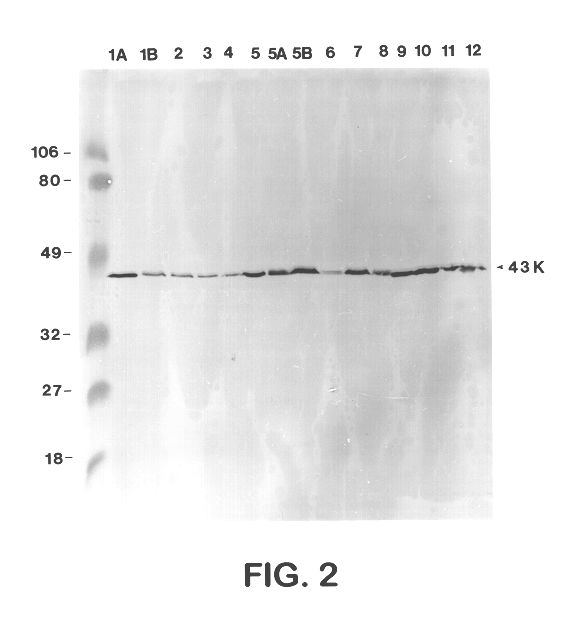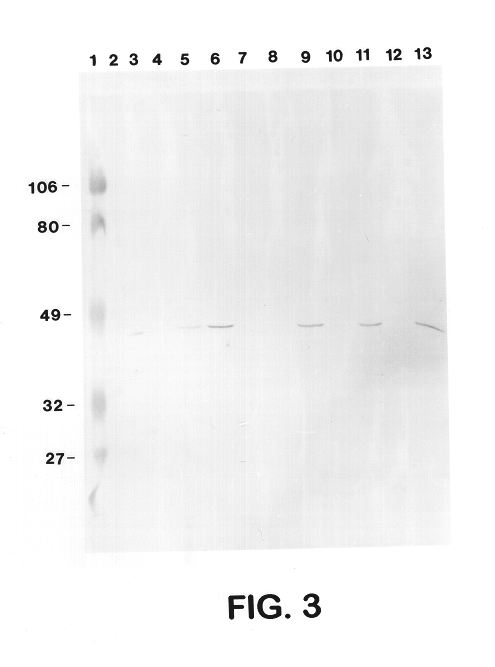43 Kd protein vaccine and method for the production thereof
a protein vaccine and protein technology, applied in the field of purified protein, can solve the problems of heterologous serotype protection, no protective immunity, sucrose density gradient centrifugation and separation is not a commercially viable method for producing the vaccine,
- Summary
- Abstract
- Description
- Claims
- Application Information
AI Technical Summary
Benefits of technology
Problems solved by technology
Method used
Image
Examples
example 2
Evaluation of the immune response of swine to the 43 Kd protein of A. pleuropneumoniae:
Sera from swine were collected from chronically infected herds; from animals experimentally infected with serotypes 1, 3, 5, and 7; and from animals vaccinated with several different vaccine preparations (including whole cell bacterins, sonicated whole cell, and outer membrane vaccines), as well as from uninfected control animals, and have evaluated the immune responses of these animals to capsular antigens and to outer membrane protein and LPS antigens of APP. Western blot analysis was used to show that both naturally and experimentally infected pigs develop an antibody response to the common 43 Kd outer membrane protein, as well as to several other OMPs, LPS, and capsular polysaccharide. Swine vaccinated with the outer membrane vaccine also develop a strong immune response to this protein.
The procedure used for Western blot analysis is as follows: outer membrane preparations, TCA-precipitated ce...
example 3
Development of monoclonal antibodies against A. pleuropneumoniae:
Monoclonal antibodies were produced against the 43 Kd OMP of APP, using the following procedures. Balb / C mice were immunized intraperitoneally with either whole killed cells of APP or with outer membranes prepared by sucrose density gradient centrifugation. Mice received a single antigen boost 4 weeks later and were sacrificed 3 days after the boost. Immune spleen cells were fused with P3-NS1-1 (NS-1) mouse myeloma cells in 50% polyethylene glycol 1500, and NS-1: spleen cell hybrids selected by culturing in hypoxanthine-aminopterin-thymidine medium. Cell cultures were screened for production of relevant antibodies by ELISA against APP outer membranes. The preferred monoclonal was 3EH7 which is deposited at Michigan State University, East Lansing, Mich. Positive clones were subcloned by limiting dilution to ensure that each clone included only a single MAb producing cell line. Positive clones were expanded to allow prod...
example 4
Assay of bactericidal activity of monoclonal antibodies against APP.
These assays demonstrate that monoclonal antibodies against the 43 Kd common OMP trigger complement mediated killing of APP cells (Table 2).
1. Bacteria:
a. Grow bacteria either in broth to mid-to-late log phase or on plates (16-18 hour culture)
b. Wash bacterial cells once with Hanks Buffered Salts Solution (HBSS).
c. Suspend bacteria in sterile HBSS to a concentration of 3.times.10.sup.8 / ml (OD520=0.3-0.4).
d. Store bacterial suspension on ice for no more than 15-20 minutes before use.
e. Dilute bacterial suspension 1:7000 just before use.
2. Antiserum:
a. Heat inactivate to denature complement, 30 minutes at 56.degree. C.
b. Dilute in sterile HBSS, in serial two-fold dilutions.
3. Complement:
a. Use pre-immune rabbit serum as a complement source.
b. Absorb the serum against the bacteria to be tested for 1 hour at 4.degree. C.--to do this, mix 1 ml serum with 1 ml bacteria (10.sup.10 per ml), let stand 1 hour at 4.degree. C....
PUM
| Property | Measurement | Unit |
|---|---|---|
| Percent by mass | aaaaa | aaaaa |
| Mass | aaaaa | aaaaa |
| Mass | aaaaa | aaaaa |
Abstract
Description
Claims
Application Information
 Login to View More
Login to View More - Generate Ideas
- Intellectual Property
- Life Sciences
- Materials
- Tech Scout
- Unparalleled Data Quality
- Higher Quality Content
- 60% Fewer Hallucinations
Browse by: Latest US Patents, China's latest patents, Technical Efficacy Thesaurus, Application Domain, Technology Topic, Popular Technical Reports.
© 2025 PatSnap. All rights reserved.Legal|Privacy policy|Modern Slavery Act Transparency Statement|Sitemap|About US| Contact US: help@patsnap.com



